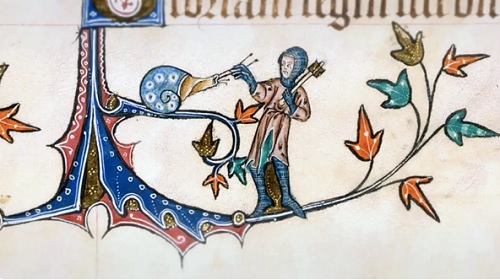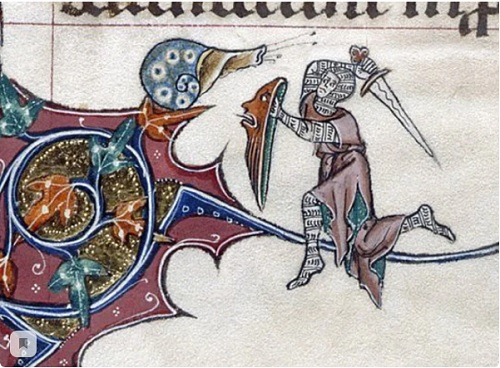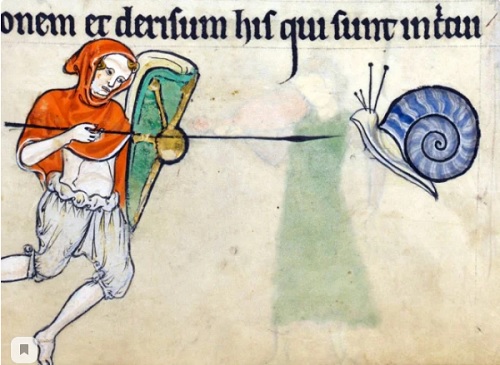It looks like you're using an Ad Blocker.
Please white-list or disable AboveTopSecret.com in your ad-blocking tool.
Thank you.
Some features of ATS will be disabled while you continue to use an ad-blocker.
19
share:
In the Middle Ages, any book was expensive, and its census was not cheap either. Often during the census, the illustrator added the so-called
marginals - drawings in the fields. Let's talk about one plot of the marginals, Cochleomachia - the battle of knights and snails.

One of the most difficult mysteries for modern medieval studies is the deciphering of symbols from the book marginals. the frequent depiction of the confrontation between a knight and a snail does not have a generally accepted interpretation (although for the people of that time everything was extremely obvious). Not infrequently, the image of the confrontation between a knight and a snail does not have a generally accepted interpretation (although for the people of that time everything was extremely obvious). Historian and art critic Lillian Randall even wrote the book "The Snail in the Gothic War", in which she put forward several versions. Let's consider them.

The first version is that the Lombardians were so designated. A very dubious version.
Second version: a cowardly knight. On the margins, the knight is often depicted as extremely surprised or shocked. But the version about the symbol of the cowardly enemy is also, to put it mildly, stretched.
The third version: this is a symbol of sin and sudden death. this is already, in my opinion, closer to the truth.
From the point of view of psychoanalysis, another, more vulgar version appears. Medieval people did not distinguish between mollusks as symbols (with the exception of the scallop shell): snails, oysters, and others - all belong to the retinue of Venus and female sexuality. The French still use a number of these words to refer to female genitalia. However, symbolic thinking is synthetic - and the shell has at least one more medieval interpretation, namely the coffin. Given the concept of carnal sin, it is not difficult to combine these two symbols and oppose the knight (a symbol, first of all, of the spirit that controls the body, and only then of honor and virtue). Freudian reminiscences of weapons as a phallic symbol are not even needed here.

Medieval marginals are primarily a play of meanings, and long before psychoanalysts, educated people of that time were also inclined to phonetic and etymological allusions. The snail in Latin is cochlea (almost also in Greek). And I think the researcher who would start digging in this direction was not mistaken. Alas, my knowledge of languages is not enough to find comparisons (especially since references could be from Latin phonetics, for example, to Old French or Occitan). Well, perhaps the most obvious: cochleas is a screw, a spiral.

By the way, I have not been able to find out in what centuries "snail" (cochleas) began to denote also a part of the inner ear. But I think the average medieval reader was clearly not knowledgeable in medical terms. So this symbolism can be swept aside.
And what do you think?
Thank.

One of the most difficult mysteries for modern medieval studies is the deciphering of symbols from the book marginals. the frequent depiction of the confrontation between a knight and a snail does not have a generally accepted interpretation (although for the people of that time everything was extremely obvious). Not infrequently, the image of the confrontation between a knight and a snail does not have a generally accepted interpretation (although for the people of that time everything was extremely obvious). Historian and art critic Lillian Randall even wrote the book "The Snail in the Gothic War", in which she put forward several versions. Let's consider them.

The first version is that the Lombardians were so designated. A very dubious version.
Second version: a cowardly knight. On the margins, the knight is often depicted as extremely surprised or shocked. But the version about the symbol of the cowardly enemy is also, to put it mildly, stretched.
The third version: this is a symbol of sin and sudden death. this is already, in my opinion, closer to the truth.
From the point of view of psychoanalysis, another, more vulgar version appears. Medieval people did not distinguish between mollusks as symbols (with the exception of the scallop shell): snails, oysters, and others - all belong to the retinue of Venus and female sexuality. The French still use a number of these words to refer to female genitalia. However, symbolic thinking is synthetic - and the shell has at least one more medieval interpretation, namely the coffin. Given the concept of carnal sin, it is not difficult to combine these two symbols and oppose the knight (a symbol, first of all, of the spirit that controls the body, and only then of honor and virtue). Freudian reminiscences of weapons as a phallic symbol are not even needed here.

Medieval marginals are primarily a play of meanings, and long before psychoanalysts, educated people of that time were also inclined to phonetic and etymological allusions. The snail in Latin is cochlea (almost also in Greek). And I think the researcher who would start digging in this direction was not mistaken. Alas, my knowledge of languages is not enough to find comparisons (especially since references could be from Latin phonetics, for example, to Old French or Occitan). Well, perhaps the most obvious: cochleas is a screw, a spiral.

By the way, I have not been able to find out in what centuries "snail" (cochleas) began to denote also a part of the inner ear. But I think the average medieval reader was clearly not knowledgeable in medical terms. So this symbolism can be swept aside.
And what do you think?
Thank.
Yes, I heard of this before. I totally think that medieval people also had a sense of humour. I sometimes look at their drawings and they are almost
cartoonish. I 'collect' [save in computer] medieval devil drawings. Most of them look funny rather than evil.
I don't think they were all serious, god fearing, boring people as we like to think of them.
Maybe the snails were an early meme. Seems they were in for a while.
What do we know.
I love anything medieval.
I don't think they were all serious, god fearing, boring people as we like to think of them.
Maybe the snails were an early meme. Seems they were in for a while.
What do we know.
I love anything medieval.
The third version: this is a symbol of sin and sudden death.
I can see where this could be a possible explanation. Maybe the snail represented the sinner? They just plod along, never changing their ways, then one day they encounter the knight, the sudden death?
a reply to: ColeYounger
I think that more than the personification of an abstract sin, but a concrete - female temptation. In the Middle Ages, most of the knightly orders consisted of celibate monks. Having succumbed to the temptation of a woman, the monk died spiritually, and the society lost the knight.
I think that more than the personification of an abstract sin, but a concrete - female temptation. In the Middle Ages, most of the knightly orders consisted of celibate monks. Having succumbed to the temptation of a woman, the monk died spiritually, and the society lost the knight.
edit on 8-9-2020 by RussianTroll because: correct
originally posted by: RussianTroll
a reply to: ColeYounger
I think that more than the personification of an abstract sin, but a concrete - female temptation. In the Middle Ages, most of the knightly orders consisted of celibate monks. Having succumbed to the temptation of a woman, the monk died spiritually, and the society lost the knight.
That makes sense. Well done.
a reply to: RussianTroll
Very interesting post, thanks.
My punt is simply this: Medieval people primarilly raised vegetables. Snails etc were a threat to survival. They could not be caught or trapped (as with rabbits) and they ate crops. Eorupe doesnt have locusts.
So the Knight is killing the dragon of the common man, who could not read so only chevked the pics.
Very interesting post, thanks.
My punt is simply this: Medieval people primarilly raised vegetables. Snails etc were a threat to survival. They could not be caught or trapped (as with rabbits) and they ate crops. Eorupe doesnt have locusts.
So the Knight is killing the dragon of the common man, who could not read so only chevked the pics.
Could that satirical twist in those “devil” drawings have been to distance one’s self from the subject, to prevent people from thinking he, or
she, is in some way involved in heretical practice? It’s a well known fact that in the middle ages people were often (wrongly) accused of being into
witchcraft and satanic rituals.
a reply to: Hecate666
a reply to: Hecate666
edit on 8-9-2020 by 2Faced because: (no reason given)
originally posted by: Doxanoxa
a reply to: RussianTroll
Very interesting post, thanks.
My punt is simply this: Medieval people primarilly raised vegetables. Snails etc were a threat to survival. They could not be caught or trapped (as with rabbits) and they ate crops. Eorupe doesnt have locusts.
So the Knight is killing the dragon of the common man, who could not read so only chevked the pics.
I think you probably nailed it.
The knight is symbolic of war and snails were a common enemy of the people.
Either that or there was an invasion of Alien snails.
originally posted by: 2Faced
Could that satirical twist in those “devil” drawings have been to distance one’s self from the subject, to prevent people from thinking he, or she, is in some way involved in heretical practice? It’s a well known fact that in the middle ages people were often (wrongly) accused of being into witchcraft and satanic rituals.
a reply to: Hecate666
That could also be. Very interesting idea.
I have seen so many medieval drawings [not just the Devil] and sometimes I don't know, they have the stupidest faces and I have to laugh. I really don't know if that was a lack in talent on behalf of the artist or if they were actually trying to make other's laugh.
a reply to: RussianTroll
Why Were Medieval Knights Always Fighting Snails?
www.smithsonianmag.com...
Why Were Medieval Knights Always Fighting Snails?
www.smithsonianmag.com...
originally posted by:
And what do you think?
This brave knight is clearly impaling the woman. She is pale as a ghost. Twisted, and bent back from the force of the spear.
Is she a zombie, controlled by the snail on her back?
Could these large, strange snails have become infected with some parasitic worm like Leucochloridium?
Interesting....
could be someone who was a farmer, but wanted to be a knight, and accidentally turned out to be an artist.
edit on 0000009030193America/Chicago12 by rom12345 because: (no reason given)
Well, the knight is always point their pointy stick at the snail who’s always taking it or seems ready to receive it. Do we need to think too
hard?
a reply to: RussianTroll
a reply to: RussianTroll
new topics
-
Just a thought by Matt Walsh on the election
2024 Elections: 3 hours ago -
Trump's truth and reconciliation commission
Politicians & People: 3 hours ago -
Liberal women going on sex strike over Trump win
US Political Madness: 4 hours ago -
Where ARE the 20 million votes??? Where ARE they????? WHERE???
US Political Madness: 5 hours ago -
President-Elect DONALD TRUMP's 2nd-Term Administration Takes Shape.
Political Ideology: 6 hours ago -
The Democratic Party’s Stay Behind Program
US Political Madness: 7 hours ago -
Celestial Objects in Far Northern Reaches of Alaska (Polar Mystery)
Fragile Earth: 8 hours ago -
82 yr Woman Arrested for Hate Crime after Assaulting Trump Supporters
2024 Elections: 10 hours ago -
Groaners II
Jokes, Puns, & Pranks: 11 hours ago
top topics
-
Where ARE the 20 million votes??? Where ARE they????? WHERE???
US Political Madness: 5 hours ago, 22 flags -
All Talk No Walk Celebrities Blowing Smoke
US Political Madness: 15 hours ago, 17 flags -
Interesting timing 40 monkeys flee medical lab in US
Diseases and Pandemics: 14 hours ago, 15 flags -
Arizona and Nevada Called for Trump – Giving Trump 312 Electoral Votes
2024 Elections: 16 hours ago, 14 flags -
The Democratic Party’s Stay Behind Program
US Political Madness: 7 hours ago, 12 flags -
President-Elect DONALD TRUMP's 2nd-Term Administration Takes Shape.
Political Ideology: 6 hours ago, 11 flags -
Just a thought by Matt Walsh on the election
2024 Elections: 3 hours ago, 11 flags -
Why Dems Are Probably Wishing Trump Won in 2020...
US Political Madness: 13 hours ago, 10 flags -
82 yr Woman Arrested for Hate Crime after Assaulting Trump Supporters
2024 Elections: 10 hours ago, 9 flags -
Celestial Objects in Far Northern Reaches of Alaska (Polar Mystery)
Fragile Earth: 8 hours ago, 7 flags
active topics
-
Where ARE the 20 million votes??? Where ARE they????? WHERE???
US Political Madness • 22 • : ksihkahe -
82 yr Woman Arrested for Hate Crime after Assaulting Trump Supporters
2024 Elections • 18 • : whereislogic -
The Democratic Party’s Stay Behind Program
US Political Madness • 6 • : berbofthegreen -
Liberal women going on sex strike over Trump win
US Political Madness • 20 • : berbofthegreen -
Trump's truth and reconciliation commission
Politicians & People • 2 • : berbofthegreen -
Why Dems Are Probably Wishing Trump Won in 2020...
US Political Madness • 3 • : namehere -
Discussing Sonia Sotomayor’s retirement is not sexist
US Political Madness • 7 • : WeMustCare -
On Nov. 5th 2024 - AMERICANS Prevented the Complete Destruction of America from Within.
2024 Elections • 119 • : WeMustCare -
-@TH3WH17ERABB17- -Q- ---TIME TO SHOW THE WORLD--- -Part- --44--
Dissecting Disinformation • 3180 • : RelSciHistItSufi -
Lunacy
Short Stories • 4 • : BingoMcGoof
19
